Col. Sudhir Farm

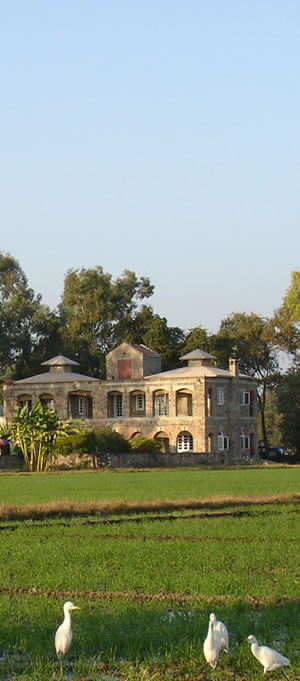


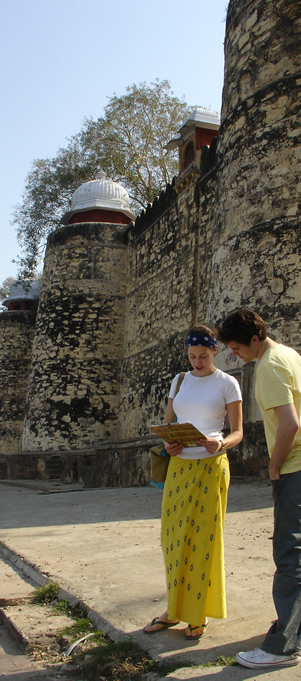

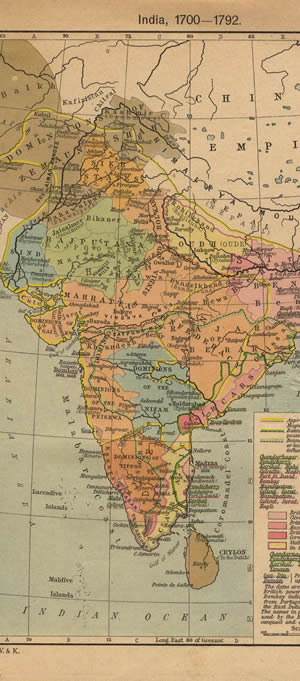
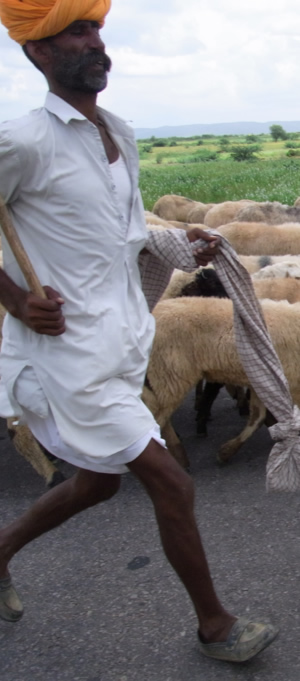
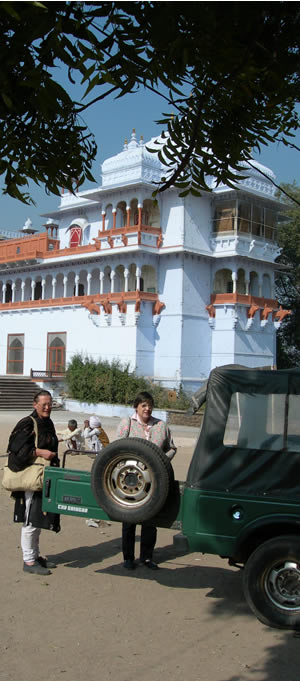
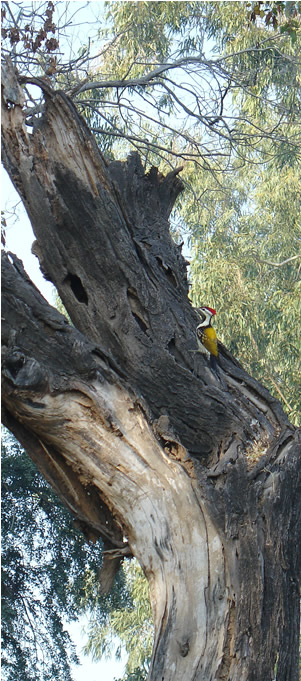
Snippets from the Visitors' Book
The Kota tonga trail was a real highlight - a bit like a 19th Century treasure hunt. It’s full of little nuggets of unusual information and fascinating glimpses into the unsolved mysteries of Kota.
Harriet and Will, London. UK
The memorial to Major Burton and his sons was much more moving than the Taj Mahal or the lake at Udaipur, marvellous as they are.
Henry Vane, Cumbria, UK
...the most comfortable bed I’ve slept in for 2 months....
Charlotte Adam, Winchester UK
Two days out of the noise and the people in a beautiful place. We felt totally
at home
- To be recommended to every person who wishes to experience the Indian country life. We also liked the way the food was prepared...
Patrick & Marie-Christine Lemaigre, Nil-St Vincent, Belgium
We’re only here for the porridge and home made bread! Thank you for a most wonderful time the memories of which we shall carry always. You have given us a wonderful & fascinating introduction to India.
Sue Turner, Lancashire, UK
So ...Rajasthan is not all desert! Thank you for sharing everything with us....
The Read family, London, UK
What a wonderful time we’ve had at the school in the village, at the weavers’, on the river, atop a tonga! Thank you for all your help and contacts throughout India
Anne Gerbner, Philadelphia, USA
It was a wonderful stay and thank you for giving us such a positive look at India and Rajasthan.
Salma Goldstein, New Jersey, USA
- There once was a lady of Kota
- Who took visitors out in her motor
- With the roads and the ruts
- It took quite some guts
- To go out with the lady of Kota.
- But once back at home on the farm
- The world quite descended to calm
- With the plants and the birds
- And fox terriers in herds
- There was balm in the calm on the farm.
Sue Millar, London, UK
After travelling around Rajasthan for two weeks, reaching a real house with books on the shelves, photos on the walls and four happy dogs was simply wonderful.
Camille Savinien, Paris, France
This isn’t tourism. I know of nowhere else where you can experience the real India as well as on your traditional working Rajasthani farm.
Sam Milward, Wellington, New Zealand
Thank you so very much for such a wonderful stay - what a fantastic introduction to India. I don’t think we’ll find such tranquillity elsewhere.
Lizzie Fortune, Hampshire. UK
Fabulous - I’ve been spoilt. It’s hard to leave and face the real world.
Elisabeth Simson, Isle of Wight, UK
After travelling around Rajasthan for two weeks, reaching a real house with books on the shelves, photos on the walls and four happy dogs was simply wonderful.
Camille Savinien, Paris, France
This isn’t tourism. I know of nowhere else where you can experience the real India as well as on your traditional working Rajasthani farm.
Sam Milward, Wellington, New Zealand
Thank you so very much for such a wonderful stay - what a fantastic introduction to India. I don’t think we’ll find such tranquillity elsewhere.
Lizzie Fortune, Hampshire. UK
Our visit at the farm was truly wonderful, off the beaten track it is a slice of India a visitor does not normally experience. Victoria is very knowledgeable about Indian culture and the people - an added perspective for us. The food here was very delicious: organically home grown ingredients, vegetables, fruits, grains prepared simply homestyle. A nice change from curries. Enjoyed the early morning boat ride and walk to the weavers. Many thanks.
Johanna Janssens, Washington, USA
I loved staying with you and the dogs and playing with the toys.
Jonas aged 8, Switzerland
A very welcome break from the crazy world of India – wonderful house, food and hospitality. Thank you so much.
Katie Buxton, Bath, UK
I loved seeing the crocodiles, and I learned a lot about deticking the puppies. Coming to the farm was a great experience.
Stella Bartholet, Washington, USA
A wonderful eye opening visit in every sense. We will be back! Thank you!
Christopher & Joanna Hobson, Northamptonshire, UK
A blissfully peaceful stay. We enjoyed everything – even the power cut. Thank you for lovely food, good company and very interesting trips.
Vicky Stark, London, UK
Exactly what we hoped for and more, bits of India off the tourist track, life as it actually is in villages, teeming life and livestock and the magic of the river.
Sir Hilary Miller, Worcester, UK
Thank you for the introduction to miniature painters, wall paintings, stories, great food, good company, walk through the fields. I loved the paintings in the City Palace and go back full of inspiration and memories.
Nan Mulder, Edinburgh, UK

On the Farm - 2006 Archive
On the Farm - December ’06
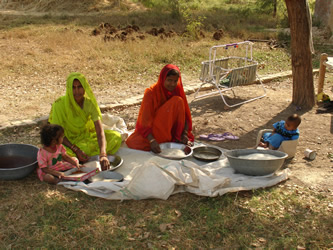 I decided to get some organic rice milled myself. For 30 kgs. paddy, 28 kgs. were milled after hand cleaning. 17.5 kgs. were left after milling. 8 kgs. whole grain rice was left after sieving. The women who sieved and hand graded the rice got the remainder 9.5 kgs. as organic baby food for their efforts. Notice the baby’ chair. It has been made out of clay soil, straw and cow dung, and, has a mud column in the middle for the baby to put its leg around and support itself.
I decided to get some organic rice milled myself. For 30 kgs. paddy, 28 kgs. were milled after hand cleaning. 17.5 kgs. were left after milling. 8 kgs. whole grain rice was left after sieving. The women who sieved and hand graded the rice got the remainder 9.5 kgs. as organic baby food for their efforts. Notice the baby’ chair. It has been made out of clay soil, straw and cow dung, and, has a mud column in the middle for the baby to put its leg around and support itself.
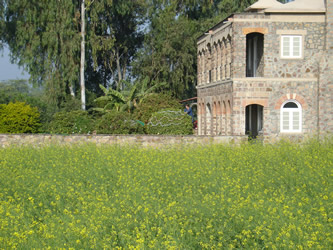 For Christmas we decorated an orange tree in the garden, seen here across the flowering mustard.
For Christmas we decorated an orange tree in the garden, seen here across the flowering mustard.
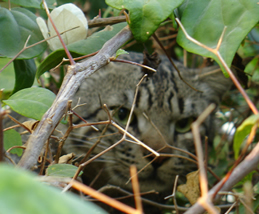 This wild cat was spotted hiding in the bougainvillaea in the garden.
This wild cat was spotted hiding in the bougainvillaea in the garden.
On the Farm - November ’06
 The paddy, having been devasted by birds, wild pigs and stray cattle was finally harvested. It was cut by hand and then beaten on a petrol drum to extract the rice. The yield from the half grown without chemical fertiliser was much less than the half grown with urea. When I sold some of my precious fragrant organic basmati rice in the market it sold for less than half the price of commercially grown varieties.
The paddy, having been devasted by birds, wild pigs and stray cattle was finally harvested. It was cut by hand and then beaten on a petrol drum to extract the rice. The yield from the half grown without chemical fertiliser was much less than the half grown with urea. When I sold some of my precious fragrant organic basmati rice in the market it sold for less than half the price of commercially grown varieties.
On the Farm - October ’06
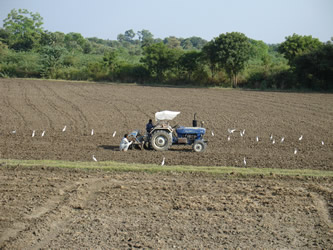 This month the land has been prepared for sowing the mustard. It was flood irrigated from the canal or from tube wells after ploughing in the luxuriant grass. One should wait for the daytime temperature to fall slightly before sowing or the seedlings will be scorched. The first fields were sown on October 10th. In two months time the whole farm will be a fluorescent yellow as the crop flowers.
This month the land has been prepared for sowing the mustard. It was flood irrigated from the canal or from tube wells after ploughing in the luxuriant grass. One should wait for the daytime temperature to fall slightly before sowing or the seedlings will be scorched. The first fields were sown on October 10th. In two months time the whole farm will be a fluorescent yellow as the crop flowers.
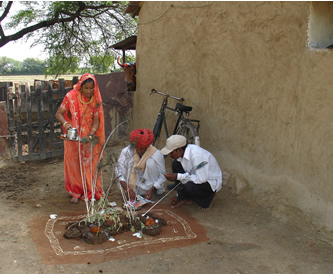
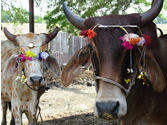 On the second day of Diwali the cows are honoured in the Govardhan Puja. They are given colourful necklaces to wear and sweet puris to eat. Here the figures of Krishna and his brother have been formed out of cow manure in front of their enclosure.
On the second day of Diwali the cows are honoured in the Govardhan Puja. They are given colourful necklaces to wear and sweet puris to eat. Here the figures of Krishna and his brother have been formed out of cow manure in front of their enclosure.
On the Farm - September ’06
The experimental patch of organic rice is coming on slowly. It was grown in a nursery plot and then transplanted out into the prepared paddy field. Rice has to be kept very wet and so uses an enormous amount of water. A lot of it is grown around here as most farmers have tube wells and it is very cheap, if not sustainable, to pump up the water. The rest of the farm looks as if it is sown with rice but it’s just luxuriant grass.
On the Farm - August ’06
I was away all August leaving competent Hindi-speaking house-sitters to man the fort, trying to keep fans on and windows open so that damp and mould would not creep up all the walls. Last year it did not rain once all August. This year quite the opposite. August is an unpredictable month, but if coming to India in August, Rajasthan is still the best state to travel around. No income for soyabean weeders this year in this area. No soyabean crop - no income for me either in October.
On the Farm - July ’06
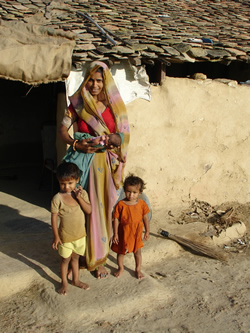 July was a month of waiting. Waiting for the rain to come so that the soyabean could be planted. When the rain did start on July 20th, it did not stop long enough for the land to dry out. Kota has had the wettest monsoon for twenty years and we were able to plant nothing except a small patch of experimentatal organic rice.
July was a month of waiting. Waiting for the rain to come so that the soyabean could be planted. When the rain did start on July 20th, it did not stop long enough for the land to dry out. Kota has had the wettest monsoon for twenty years and we were able to plant nothing except a small patch of experimentatal organic rice.
A new baby was born on the farm this month. The baby at full term weighed 1.5kgs at birth. “Of the estimated 20 million low-weight births (less than 2.5kg) each year in the developing world, more than one third (7.8 million) are in India” (Source: Progress for Children A Report Card on Nutrition, UNICEF. May 2006). It should be taken into account, however, that the mother probably weighs less than 40kg.
On the Farm - June ’06
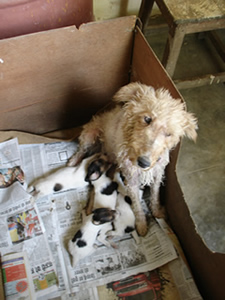 June has been a month of cutting and thinning the thorny border hedges and clearing the thorn bushes that spring up between the fields like bramble patches. The 'gobar' or cow manure collected over the year, is scattered manually in the fields. Fifteen tractor trailer-loads have been filled by hand using metal basins carried on the head.
June has been a month of cutting and thinning the thorny border hedges and clearing the thorn bushes that spring up between the fields like bramble patches. The 'gobar' or cow manure collected over the year, is scattered manually in the fields. Fifteen tractor trailer-loads have been filled by hand using metal basins carried on the head.
After unusually early heavy rain on 1st June the weeds have germinated and sprung up and so on 18th June they were ploughed in. After the next rain soya bean can be planted.
This photo shows Rosie and her fox terrier puppies born on 31st May. She is looking faded and jaded but the four puppies are thriving despite the high temperatures, humidity and daily four-hour power cuts
On the Farm - May ’06
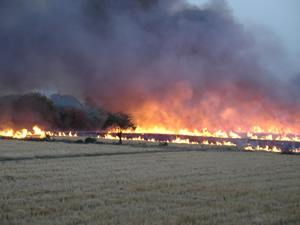 In May, the farm is resting and awaiting the first pre-monsoon showers. Where mustard or wheat was grown and hand cut the stubble has been ploughed in. Where the combine harvester cut the crop the stalks are longer and stubble burning is the accepted practice. This adds nutrients to the soil in the form of ash and provides a good evening's entertainment for local pyromaniacs. The only equipment used to control the burning are green whippy branches pulled off the trees with which to beat out the flames when they overstep the required boundaries. This is not always successful and we have a couple of lengths of burnt out boundary hedge to prove it, but the trees are unaffected or if scorched quickly recover.
In May, the farm is resting and awaiting the first pre-monsoon showers. Where mustard or wheat was grown and hand cut the stubble has been ploughed in. Where the combine harvester cut the crop the stalks are longer and stubble burning is the accepted practice. This adds nutrients to the soil in the form of ash and provides a good evening's entertainment for local pyromaniacs. The only equipment used to control the burning are green whippy branches pulled off the trees with which to beat out the flames when they overstep the required boundaries. This is not always successful and we have a couple of lengths of burnt out boundary hedge to prove it, but the trees are unaffected or if scorched quickly recover.
Maintenance of the hedges will be done this month and the gaps mended with thorny branches from bush which grows everywhere. Wire fencing and metal posts cannot be used as they are stolen for scrap. Even long stone posts are taken for house building. With no crops sown there will be little attraction for the numerous wandering cows to encroach. People bring their cattle from interior areas to graze in the fields in return for fertilising them with cattle manure. More on this next month.
Daytime temperature has touched 46 degrees Celsius.
On the Farm - April ’06
 April is harvest month and a traditional time for village weddings after the crops have been sold. It is already 38C during the day and a minumum of 26C at night. As the annuals dry up many trees explode with new luminous green leaves within the space of a few days. The gulmohar tree by the well which was bare a week ago, has put forth leaves and will soon be covered in bright orange flowers. I have gone into summer mode and moved downstairs to sleep. We still have daily power cuts from 8.00am -12.00pm and I now use the generator for most of that time.
April is harvest month and a traditional time for village weddings after the crops have been sold. It is already 38C during the day and a minumum of 26C at night. As the annuals dry up many trees explode with new luminous green leaves within the space of a few days. The gulmohar tree by the well which was bare a week ago, has put forth leaves and will soon be covered in bright orange flowers. I have gone into summer mode and moved downstairs to sleep. We still have daily power cuts from 8.00am -12.00pm and I now use the generator for most of that time.
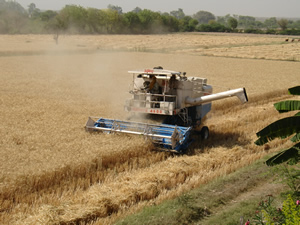 April 6. As I write, there are four large piles of wheat waiting at the grain market for it to open tomorrow, today being yet another holiday. A combine harvester came yesterday and effortlessly dealt with most of the wheat in a few hours. The yield is better if you use a combine and the price is high currently as there is a wheat shortage in India after many years of plenty. Wheat is being imported to keep the price down, an anti-farmer measure if ever there was one.
April 6. As I write, there are four large piles of wheat waiting at the grain market for it to open tomorrow, today being yet another holiday. A combine harvester came yesterday and effortlessly dealt with most of the wheat in a few hours. The yield is better if you use a combine and the price is high currently as there is a wheat shortage in India after many years of plenty. Wheat is being imported to keep the price down, an anti-farmer measure if ever there was one.
The remaining wheat will be cut by hand starting on April 8th. It will be a week from start to finish and the main economic advantage is that you get the straw minced by the thresher which can be used as fodder for the cows. A combine harvester, on the otherhand, leaves most of the straw in the field where it has to be burnt. There is no baler attached to the combine. With so little bhoosa (straw) being offered for sale the price is high which means that it becomes cheaper to have the wheat hand cut than to pay for the combine.
Labourers are paid in wheat which is how they get their wheat for home consumption for the year. The social advantage of cutting by hand is the employment that it offers and the chance for local people to use their labour to acquire their wheat. It is in fact hard to find people who are prepared and willing to toil for 8 hrs in 40C. If they have been to school they will not have built up the necessary stamina to cope. Migrant labour increasingly comes from interior villages where no crops can be grown because of the lack of water. Whole families come and camp locally and then return to their villages with their sacks of wheat.
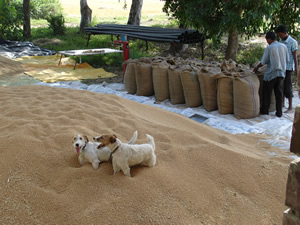 When I'm weighing the sacks I offer to weigh the workers too. Some fully grown men weigh under 50 kgs i.e. 8 stone. Some of the women weigh under 6 stone and yet have the stamina to work in the hot sun all day.
When I'm weighing the sacks I offer to weigh the workers too. Some fully grown men weigh under 50 kgs i.e. 8 stone. Some of the women weigh under 6 stone and yet have the stamina to work in the hot sun all day.
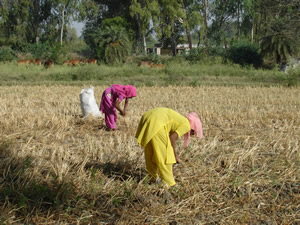 A timeless picture of women gleaners picking up broken stalks of wheat after the harvest.
A timeless picture of women gleaners picking up broken stalks of wheat after the harvest.
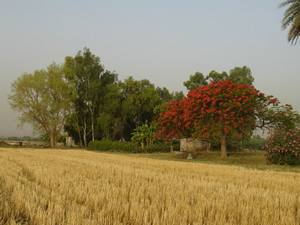 The crops have been harvested and sold. The trees and bushes are resplendent with flowers in stark contrast to the golden wheat stubble left behind by the combine harvester. The hot dry summer is upon us when temperatures hover around 40C during the day and 30C at night. This is what it is like in the last week of April.
The crops have been harvested and sold. The trees and bushes are resplendent with flowers in stark contrast to the golden wheat stubble left behind by the combine harvester. The hot dry summer is upon us when temperatures hover around 40C during the day and 30C at night. This is what it is like in the last week of April.
On the Farm - March ’06
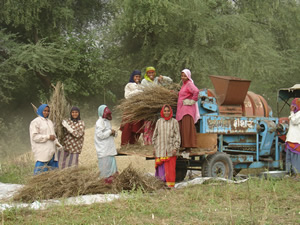 March marks the beginning of the harvest season. The mustard has been cut and the wheat is ripening. After drying in the fields for a few days, the mustard is piled up into gallas or stacks for threshing. Two gangs of women have taken this work on contract. They wear mens' shirts and bandanas over their saris to protect themselves from the sharp mustard stalks. It used to be men's work to feed the thresing machine but now the women are expected to take this on too.
March marks the beginning of the harvest season. The mustard has been cut and the wheat is ripening. After drying in the fields for a few days, the mustard is piled up into gallas or stacks for threshing. Two gangs of women have taken this work on contract. They wear mens' shirts and bandanas over their saris to protect themselves from the sharp mustard stalks. It used to be men's work to feed the thresing machine but now the women are expected to take this on too.
The government has a scheme for buying mustard seed at a minimum support price. This is 15% over the market price and to prevent traders buying from the farmers and passing it off as their own produce we have to get a certificate from the local patwari or land records clerk to prove that we have grown it. I have passed this first hurdle. The next is to obtain a token and a date for presenting the crop to avoid having to wait in a queue for days. As it will be stored here I must buy good quality old sugar sacks in which to store it. It is much easier to thresh directly into a trailer and to sell the unbagged crop immediately for ready cash. To cut and run so to speak. The moisture content has to be low before the government will buy it and as it is raining at the moment and the cut crop is still out in the field, I may not have a choice.
The women have already asked me for their Holi sweets. This Spring Festival of Holi is on March 14th and is marked with singing, dancing, drinking, and throwing of colour on each other which may be in the form of water dyes or the more gentle "dry Holi" with coloured powders.
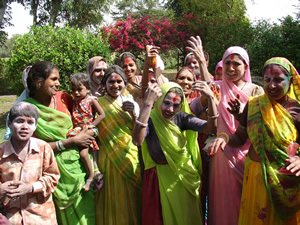 It is 15 March. The women, and some children, appeared at my doorstep today, covered in colourful dyes. They were a good-natured bunch, who danced and smiled and they respectfully put colour on my feet. They were given sweets, and any men who appeared a tot of rum.
It is 15 March. The women, and some children, appeared at my doorstep today, covered in colourful dyes. They were a good-natured bunch, who danced and smiled and they respectfully put colour on my feet. They were given sweets, and any men who appeared a tot of rum.

